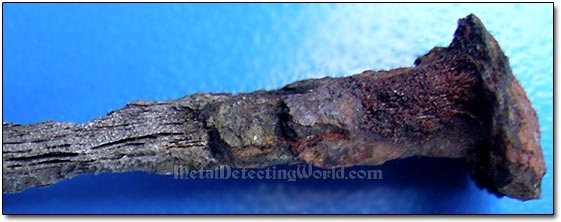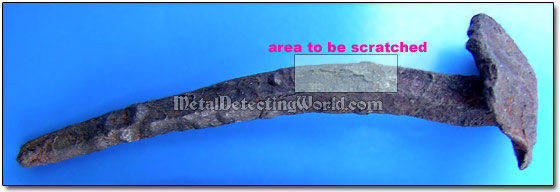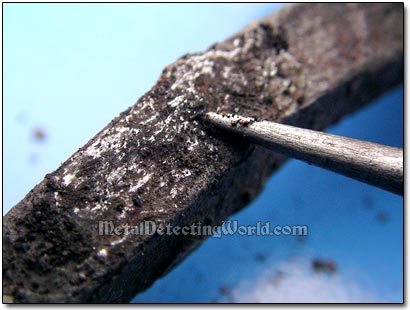Removing Rust with Electrolysis - A Detailed Illustrated Tutorial, page 6
1. Introduction:
Comparing Effects of Coca-Cola, Vinegar and Electrolytic Rust Removal Methods
(...CONTINUED from Previous Page)
The next picture shows a dramatic effect of Vinegar on the nail's surface. In this case, I did not have to scratch any layer as the picture itself explains what might happen if an iron artifact is excessively treated with Vinegar. Basically, if you leave an iron object in a vinegar solution for more than six to eight hours without checking on it, the vinegar will eventually dissolve the iron.
Vinegar Had Attacked and Destroyed Base Iron Metal; Rusty Spots Still Remaining

The iron nail in the Electrolysis group had some spots of converted rust covered with black coating (Sodium Carbonate) on its surface. These spots survived the wire brushing because the Sodium Carbonate was not cleaned off while wet (see details in the "What is the Black Coating and How to Clean It Off" section on page 27).
This Iron Nail, ca. 1600s, Was Electrolytically Cleaned but Not Thoroughly Wire Brushed

I used a scratch awl to remove the blackened scale at the spot. The scale gave in and broke in pieces without resistance, and "healthy" iron metal appeared underneath. By far, the Electrolysis method showed the best results. All you have to do past electrolysis (and before proceeding with conservation and preservation techniques) is to clean the freshly derusted artifacts promptly and thoroughly.
Base Metal Appeared Underneath the Black Coating

As for the Phosphating, if it is applied properly, it can be used as the post-electrolysis technique for iron conservation and preservation, especially if you are going to paint your relic. By using a solution of Phosphoric acid (5%) and water (95%) you can even protect your freshly derusted artifact from getting rusted again. You just have to allow the artifact to form a thin coat of rust after the electrolysis treatment, and then cover it with the prepared solution. An iron phosphate coating will appear. With its highly bondable surface, Iron Phosphate would be an excellent primer coat for painting. During phosphating of iron artifacts, two metals, Chromium and Aluminum, should be kept away as they can be easily consumed by Phosphoric acid.
CONCLUSION:
Besides Electrolysis, there are various methods of rust removal, but these methods are unsuitable for very old or valuable iron artifacts because, along with the rust, some of the base metal is also removed. Dissolving the rust with acids can produce good results, but this process can remove surface features which otherwise could have been preserved in the rust. All rust removing methods including electrolysis CANNOT undo any rust damage, but the electrolysis has many advantages over other methods because it can:
• Derust iron objects of any size: from a small square nail to a huge ship anchor.
• Avoid removal of iron metal, even if you keep "cooking the soup" for an extra day, in contrast to some chemical treatments.
• Extract the rust from inside the microscopic cracks and crevices where mechanical applications can not reach.
• Avoid extensive scratching which occurs with abrasive methods.
• Unstick the iron and steel parts that are firmly stuck after having rusted together.
• Derust the complex interiors of small, medium and large mechanisms.
• Get a job done without operator's laborious involvement.
• Not be noisy, highly hazardous, injurious and caustic.
• Be operated in the rainy or snowy-subzero outdoor conditions during the winter months (actually the best time to do it!)
The tiny gaps between mechanical parts, such as a gap between piston and cylinder in the car engine, can be very tough to electrolyze because the flow of an electric current might not be able to "reach" all the way inside and develop a large field of voltage. Even if a gap could be moisten with the solution, the massive surrounding area will absorb the current's flow and prevent it from getting down into the gap. In this case, the vinegar or WD-40 treatment would work. This is probably the only disadvantage of electrolytic cleaning over other methods.
Cleaning times for various rusted iron objects depend on many factors such as object's size, size of negative electrodes (Anodes), amount of rust, amount of voltage and current applied, etc. (see details in the "Time Required for Complete Derusting" section on page 20).
Overall, even if a simple electrolytic setup, often crude in design, consisting of household items is utilized, the electrolysis proves to be the most effective method of removing rust from iron objects as long as attention is paid to details.